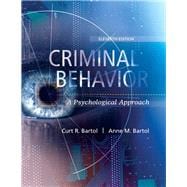A comprehensive psychological approach to criminal and antisocial behavior.
Building on a tradition of excellence, Criminal Behavior: A Psychological Approachis accurate, well-researched, contemporary, and comprehensive. It offers a detailed look at crime, what may lead to it, and how criminal behavior may be prevented — all from a psychological perspective. With a focus on serious crimes, particularly those involving violence, this text offers an all-inclusive look at a very complex field through effective and engaging material that has been classroom-tested for more than thirty years.
Now in the Eleventh Edition, you’ll find crucial updates relating to crime definitions and DSM-5 categories, as well as the most current statistics and recently proposed models and theories. Numerous topics — such as intimate partner violence, juvenile sex offending, terrorist recruitment, elderly abuse, and sexual burglary — now receive more extensive coverage than ever before.








